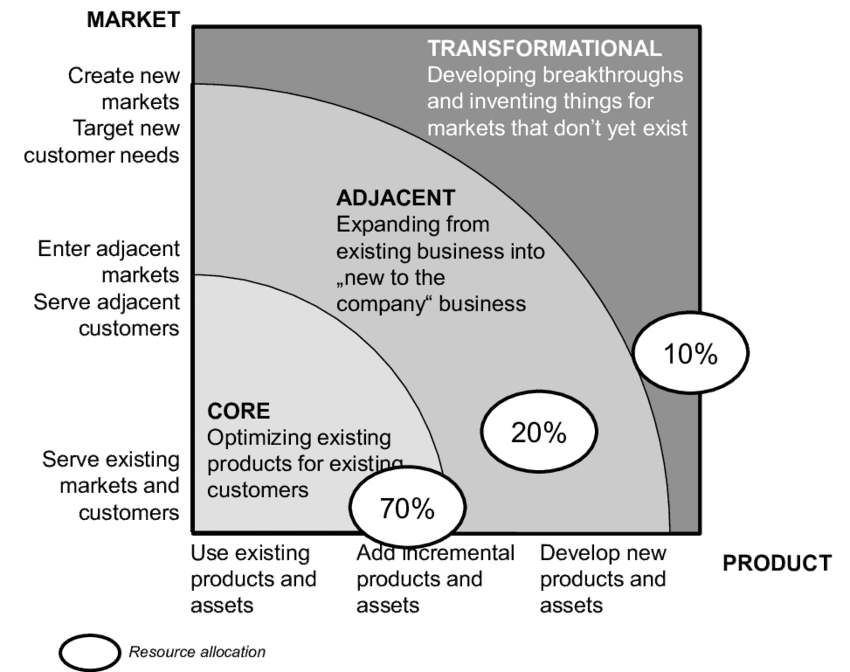Innovation Ambition Matrix
🔥 Building on and refining
Ansoff's Product/Market Grid (1957), the Innovation Ambition Matrix is a strategic framework introduced in a 2012 Harvard Business Review article titled “Managing Your Innovation Portfolio” by Bansi Nagji and Geoff Tuff. It can be used by organizations to manage their innovation portfolio by differentiating their innovation efforts into three categories based on two dimensions—product and market.
The Axes of the Innovation Ambition Matrix
The X-axis represents the type of product or asset used:
• Core: Existing products.
• Adjacent: Incremental additions to existing products.
• Transformational: New product development.
The Y-axis represents the market or customer segment:
• Serving existing markets/customers.
• Entering adjacent markets.
• Creating new markets.

Three categories of innovation
- Core Innovation: Core innovations focus on improving existing products, services, or processes within the organization's current markets and technologies. They build upon the organization’s existing strengths and customer base, and aim to improve efficiency, enhance existing features, or optimize processes.
Examples include incremental product updates, cost-saving measures, or process enhancements. Smartphone manufacturers, like Apple, regularly release new models with improved features, such as better cameras, faster processors, and longer battery life, to maintain their market competitiveness.
- Adjacent Innovation: Adjacent innovations involve exploring new opportunities adjacent to the organization's core business. These innovations leverage existing capabilities or assets to explore potential in related markets or with slightly different customer segments. They often leverage current capabilities but apply them in new ways, therefore they carry moderate risk but offer opportunities for growth.
Examples include diversifying product lines, entering adjacent markets, or adapting existing solutions for different contexts. While its core business revolves around its extensive library of movies and TV shows, Netflix has also expanded into live sports streaming, offering a diverse range of content to its subscribers.
- Transformational Innovation: Transformational innovations entail creating entirely new markets or disrupting existing ones through creating brand new products, services, or business models. They require significant investment, risk-taking, and exploration of uncharted territory, but have the potential to disrupt existing markets or create new ones to generate significant competitive advantages.
Examples include breakthrough technologies, novel business models, or radical shifts in strategy. SpaceX transformed space exploration by reimagining rocket technology. It developed reusable first-stage boosters that can return to Earth after launch, challenging traditional aerospace norms and opening the door to ambitious missions like Mars colonization.
How to Use the Innovation Ambition Matrix
• Teams place their ideas on the matrix based on where they fit in terms of product type and market.
• The resulting visual helps align everyone toward a common vision for the product’s direction.
• It encourages innovation by considering both existing and new opportunities.
Finding an Optimal Innovation Balance
Research suggests that allocating resources in an approximate ratio yields good results and balances short-term growth with long-term bets:
• 70% Core: Focusing on existing products and serving current markets.
• 20% Adjacent: Adopting incremental innovations.
• 10% Transformational: Exploring new products and markets.
Benefits of the the Innovation Ambition Matrix
• Helps organizations prioritize and allocate resources effectively.
• Guides decision-making on innovation initiatives.
• Ensures a mix of stability and exploration.
The Innovation Ambition Matrix provides organizations with a structured and balanced approach to manage their innovation portfolio with efficiency. It allows them to optimize resource allocation to innovation initiatives across different levels and synchronize their innovation strategies with their overall business objectives.
Sources:
Nagji, B., & Tuff, G. (2012). Managing Your Innovation Portfolio. Harvard Business Review.
Skillicorn, N. (2021). What is the ambition matrix and how does it work as part of an innovation portfolio? Idea to Value.
F.Dieffenbacher, S. (2023). 50 Innovation Examples: Exciting Innovative Ideas in Business. Digital Leadership.
16-4-2024




Comments by date▼